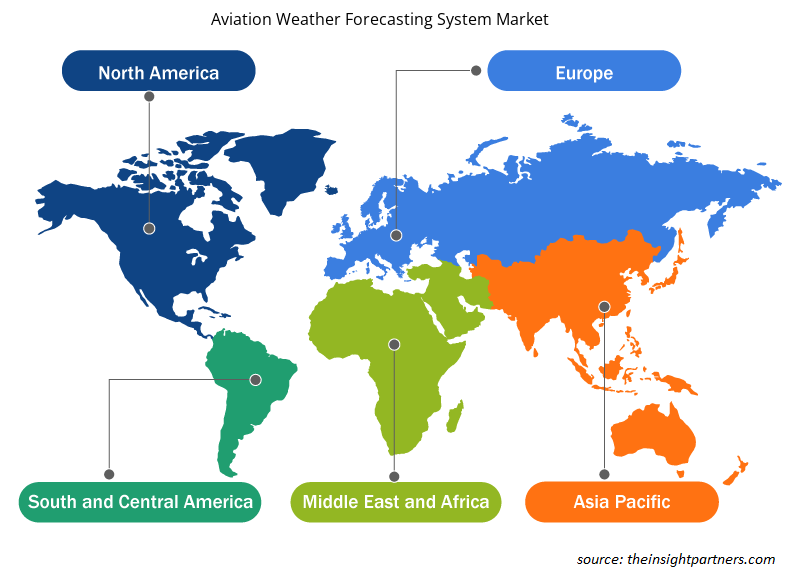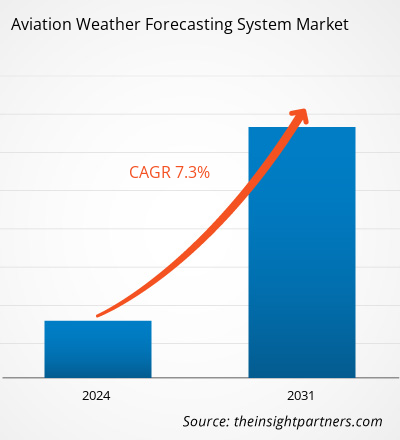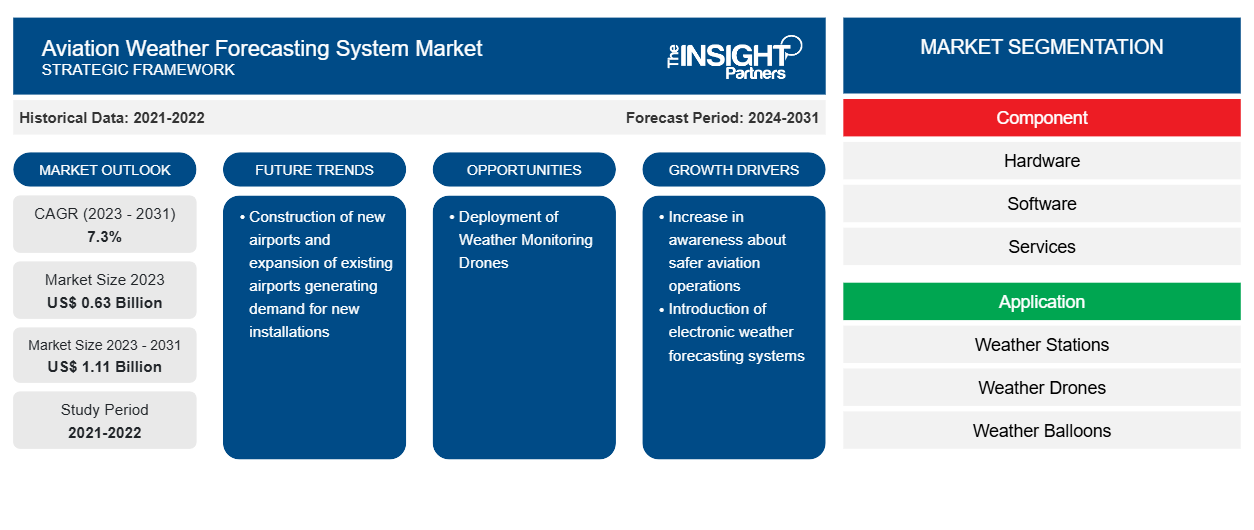Der Markt für Wettervorhersagesysteme für die Luftfahrt wird voraussichtlich von 0,63 Milliarden US-Dollar im Jahr 2023 auf 1,11 Milliarden US-Dollar im Jahr 2031 anwachsen. Der Markt wird zwischen 2023 und 2031 voraussichtlich eine durchschnittliche jährliche Wachstumsrate (CAGR) von 7,3 % verzeichnen. Der Bau neuer Flughäfen und die Erweiterung bestehender Flughäfen, die eine Nachfrage nach neuen Anlagen erzeugen, dürfte ein wichtiger Trend auf dem Markt bleiben.
Marktanalyse für Wettervorhersagesysteme für die Luftfahrt
Einige der wichtigsten Akteure auf dem globalen Markt für Flugwettervorhersagesysteme sind Collins Aerospace, ENAV SpA, IBM Corporation, Vaisala und Campbell Scientific Inc. Der Markt ist stark konsolidiert, wobei mehrere namhafte Akteure die inländische und internationale Nachfrage bedienen. Laut der Marktforschungsstudie zu Flugwettervorhersagesystemen erobern diese Akteure kumulativ einen größeren Anteil am globalen Markt für Flugwettervorhersagesysteme als die anderen Unternehmen.
Marktübersicht für Wettervorhersagesysteme für die Luftfahrt
Zu den Akteuren im Bereich der Flugwettervorhersagesysteme gehören sowohl Hardwarehersteller als auch Softwareanbieter, die voneinander abhängig sind. Die Hardwarehersteller und Softwareanbieter sind Collins Aerospace, IBM Corporation, Campbell Scientific Inc, Sutron, DTN, Spire Global, Universal Weather and Aviation Inc, Vaisala, Ubimet und viele mehr. Auf dem Markt für Flugwettervorhersagesysteme sind viele kleine Akteure tätig, die einen erheblichen Anteil des Weltmarkts innehaben. Die kleinen Akteure sind auch an F&E-Aktivitäten zur Entwicklung neuer Technologien beteiligt, die den Markt in den kommenden Jahren weiter vergrößern werden. Diese Organisationen haben im Laufe der Jahre ihre Investitionen in die Entwicklung neuer und fortschrittlicher Flugwettervorhersagesysteme entsprechend den wachsenden Kundenanforderungen mit Hilfe staatlicher Regulierungsbehörden erhöht. Die staatliche Regulierungsbehörde unterstützt sowohl Hardwarehersteller als auch Softwareanbieter des Flugwettervorhersagesystems, indem sie den Militärflughafen und kommerzielle Flughäfen mit Aufträgen versorgt.
Passen Sie diesen Bericht Ihren Anforderungen an
Sie erhalten kostenlos individuelle Anpassungen an jedem Bericht, einschließlich Teilen dieses Berichts oder einer Analyse auf Länderebene, eines Excel-Datenpakets sowie tolle Angebote und Rabatte für Start-ups und Universitäten.
-
Holen Sie sich die wichtigsten Markttrends aus diesem Bericht.Dieses KOSTENLOSE Beispiel umfasst eine Datenanalyse von Markttrends bis hin zu Schätzungen und Prognosen.
Markttreiber und Chancen für Wettervorhersagesysteme für die Luftfahrt
Einführung elektronischer Wettervorhersagesysteme
Die Einführung und Nutzung elektronischer Systeme zur Wettervorhersage veranlasst die Marktanbieter, innovative Produkte zu entwickeln und der wachsenden Nachfrage gerecht zu werden. Darüber hinaus ergreifen mehrere Flughäfen Initiativen, um elektronische Wetterüberwachungssysteme auf ihren Start- und Landebahnen und auf dem Flughafengelände zu installieren, um einen sichereren Betrieb der Einrichtungen zu gewährleisten. So kündigte beispielsweise der Salida Airport-Harriet Alexander Field (KANK) in Colorado im Januar 2024 die Eröffnung und Inbetriebnahme seines neuen hochmodernen elektronischen Wettersystems an, das es dem Flughafen ermöglicht, Landevorgänge sicherer durchzuführen und einen besseren Überblick über die Luftbedingungen am Flughafen zu erhalten.
Einsatz von Wetterüberwachungsdrohnen
Wetterdrohnen sind speziell dafür konzipiert, in der untersten Schicht der Erdatmosphäre (der Grenzschicht) zu fliegen, und sie sind mit Sensoren ausgestattet, die Informationen zu Temperatur, Wind, Luftfeuchtigkeit, Gewittern und Luftdruck in der Atmosphäre sammeln. Der Einsatz von Drohnen zur Erfassung von Wetterdaten ist einer der Hauptfaktoren, der im Prognosezeitraum voraussichtlich enorme Chancen für Marktanbieter schaffen wird. Diese Drohnen sind mit thermodynamischen Sensoren ausgestattet, die Wetterdaten wie Luftfeuchtigkeit, Druck und Temperatur erfassen und an Wetterstationen melden. Echtzeit-Vorhersagesysteme können diese Daten an Flughäfen nutzen. Das Echtzeit-Vorhersagesystem verwendet die Daten dann, um Wettervorhersagen und Updates für die Luftverkehrsumgebung bereitzustellen. Mehrere Organisationen arbeiten derzeit an effizienteren Drohnendatenerfassungssystemen, um zuverlässigere Drohnenwetterüberwachungssysteme zu entwickeln, die genutzt werden können, um genauere und Echtzeitdaten für Wettervorhersagesysteme in der gesamten Luftfahrtindustrie bereitzustellen.
Segmentierungsanalyse des Marktberichts zum Wettervorhersagesystem für die Luftfahrt
Wichtige Segmente, die zur Ableitung der Marktanalyse für Flugwettervorhersagesysteme beigetragen haben, sind Komponente, Anwendung und Prognosetyp.
- Basierend auf den Komponenten ist der Markt für Flugwettervorhersagesysteme in Hardware, Software und Dienstleistungen segmentiert. Das Hardwaresegment hielt im Jahr 2023 einen größeren Marktanteil.
- Basierend auf der Anwendung ist der Markt für Wettervorhersagesysteme für die Luftfahrt in Wetterstationen, Wetterdrohnen, Wetterballons und andere unterteilt. Das Segment Wetterstationen hatte im Jahr 2023 einen größeren Marktanteil.
- Basierend auf der Prognoseart ist der Markt für Flugwettervorhersagesysteme in Kurzstrecken, Mittelstrecken, erweiterte Reichweite und Langstrecken segmentiert. Das Kurzstreckensegment hatte im Jahr 2023 einen größeren Marktanteil.
Marktanteilsanalyse für Luftfahrtwettervorhersagesysteme nach Geografie
Der geografische Umfang des Marktberichts über Flugwettervorhersagesysteme ist hauptsächlich in fünf Regionen unterteilt: Nordamerika, Europa, Asien-Pazifik, Naher Osten und Afrika sowie Südamerika.
Nordamerika dominierte den Markt im Jahr 2023, gefolgt von Europa und dem asiatisch-pazifischen Raum. Darüber hinaus dürfte der asiatisch-pazifische Raum in den kommenden Jahren auch die höchste durchschnittliche jährliche Wachstumsrate verzeichnen. Zwei der bevölkerungsreichsten Länder im asiatisch-pazifischen Raum, nämlich China und Indien, haben bereits ihre Zukunftspläne für den Bau neuer Flughäfen angekündigt. So kündigte die indische Regierung im Jahr 2023 ihre Pläne an, bis Ende 2025 80 neue Flughäfen im Land zu bauen. Ebenso hat China seine Pläne angekündigt, bis Ende 2035 216 neue Flughäfen zu bauen. Dies dürfte den Aufbau des Marktes für Flugwettervorhersagesysteme im gesamten asiatisch-pazifischen Raum in den kommenden Jahren weiter vorantreiben.
Regionale Einblicke in den Markt für Wettervorhersagesysteme für die Luftfahrt
Die regionalen Trends und Faktoren, die den Markt für Wettervorhersagesysteme für die Luftfahrt im gesamten Prognosezeitraum beeinflussen, wurden von den Analysten von Insight Partners ausführlich erläutert. In diesem Abschnitt werden auch die Marktsegmente und die Geografie von Wettervorhersagesystemen für die Luftfahrt in Nordamerika, Europa, im asiatisch-pazifischen Raum, im Nahen Osten und Afrika sowie in Süd- und Mittelamerika erörtert.

- Erhalten Sie regionale Daten zum Markt für Wettervorhersagesysteme für die Luftfahrt
Umfang des Marktberichts über Wettervorhersagesysteme für die Luftfahrt
| Berichtsattribut | Details |
|---|---|
| Marktgröße im Jahr 2023 | 0,63 Milliarden US-Dollar |
| Marktgröße bis 2031 | 1,11 Milliarden US-Dollar |
| Globale CAGR (2023 - 2031) | 7,3 % |
| Historische Daten | 2021-2022 |
| Prognosezeitraum | 2024–2031 |
| Abgedeckte Segmente |
Nach Komponente
|
| Abgedeckte Regionen und Länder |
Nordamerika
|
| Marktführer und wichtige Unternehmensprofile |
|
Dichte der Marktteilnehmer für Wettervorhersagesysteme für die Luftfahrt: Verständnis ihrer Auswirkungen auf die Geschäftsdynamik
Der Markt für Wettervorhersagesysteme für die Luftfahrt wächst rasant, angetrieben durch die steigende Nachfrage der Endnutzer aufgrund von Faktoren wie sich entwickelnden Verbraucherpräferenzen, technologischen Fortschritten und einem größeren Bewusstsein für die Vorteile des Produkts. Mit steigender Nachfrage erweitern Unternehmen ihr Angebot, entwickeln Innovationen, um die Bedürfnisse der Verbraucher zu erfüllen, und nutzen neue Trends, was das Marktwachstum weiter ankurbelt.
Die Marktteilnehmerdichte bezieht sich auf die Verteilung der Firmen oder Unternehmen, die in einem bestimmten Markt oder einer bestimmten Branche tätig sind. Sie gibt an, wie viele Wettbewerber (Marktteilnehmer) in einem bestimmten Marktraum im Verhältnis zu seiner Größe oder seinem gesamten Marktwert präsent sind.
Die wichtigsten Unternehmen auf dem Markt für Wettervorhersagesysteme für die Luftfahrt sind:
- Campbell Scientific Inc
- Collins Luft- und Raumfahrt
- IBM Corporation
- Sutron Corporation
- Vaisala
- Universal Weather und Aviation Inc.
Haftungsausschluss : Die oben aufgeführten Unternehmen sind nicht in einer bestimmten Reihenfolge aufgeführt.

- Überblick über die wichtigsten Akteure auf dem Markt für Wettervorhersagesysteme für die Luftfahrt
Marktnachrichten und aktuelle Entwicklungen zu Wettervorhersagesystemen für die Luftfahrt
Der Markt für Wettervorhersagesysteme für die Luftfahrt wird durch die Erhebung qualitativer und quantitativer Daten nach Primär- und Sekundärforschung bewertet, die wichtige Unternehmensveröffentlichungen, Verbandsdaten und Datenbanken umfasst. Nachfolgend sind einige der Entwicklungen auf dem Markt für Wettervorhersagesysteme für die Luftfahrt aufgeführt:
- Eine Partnerschaft zwischen dem Met Office, FLYHT Aerospace Solutions Ltd. (TSX-V: FLY) (OTCQX: FLYLF) und Loganair zielt darauf ab, die Genauigkeit von Wettervorhersagen und die Vorhersage lokaler Unwetter in Großbritannien zu verbessern, mit erwarteten Vorteilen für die Luftfahrtindustrie, wie etwa einer effizienteren Routenplanung und der Unterstützung von Zielen zur Reduzierung der CO2-Emissionen. (Quelle: Met Office, Pressemitteilung, August 2023)
- Empresa Argentina de Navegación Aérea gab den Abschluss der Installationsarbeiten von drei neuen automatischen Wetterbeobachtungssystemen (AWOS) an den Flughäfen San Miguel de Tucumán, San Salvador de Jujuy und Salta Argentina bekannt. (Quelle: Empresa Argentina de Navegación Aérea, Pressemitteilung, Januar 2022)
Marktbericht zu Wettervorhersagesystemen für die Luftfahrt – Umfang und Ergebnisse
Der Bericht „Marktgröße und Prognose für Wettervorhersagesysteme für die Luftfahrt (2021–2031)“ bietet eine detaillierte Analyse des Marktes, die die folgenden Bereiche abdeckt:
- Marktgröße und Prognose für Luftfahrtwettervorhersagesysteme auf globaler, regionaler und Länderebene für alle wichtigen Marktsegmente, die im Rahmen des Berichts abgedeckt sind
- Markttrends für Wettervorhersagesysteme für die Luftfahrt sowie Marktdynamiken wie Treiber, Beschränkungen und wichtige Chancen
- Detaillierte Porter's Five Forces Analyse
- Marktanalyse für Wettervorhersagesysteme für die Luftfahrt, die wichtige Markttrends, globale und regionale Rahmenbedingungen, wichtige Akteure, Vorschriften und aktuelle Marktentwicklungen umfasst
- Branchenlandschaft und Wettbewerbsanalyse, die die Marktkonzentration, Heatmap-Analyse, prominente Akteure und aktuelle Entwicklungen auf dem Markt für Flugwettervorhersagesysteme umfasst
- Detaillierte Firmenprofile
- Historische Analyse (2 Jahre), Basisjahr, Prognose (7 Jahre) mit CAGR
- PEST- und SWOT-Analyse
- Marktgröße Wert/Volumen – Global, Regional, Land
- Branchen- und Wettbewerbslandschaft
- Excel-Datensatz
Aktuelle Berichte
Erfahrungsberichte
Grund zum Kauf
- Fundierte Entscheidungsfindung
- Marktdynamik verstehen
- Wettbewerbsanalyse
- Kundeneinblicke
- Marktprognosen
- Risikominimierung
- Strategische Planung
- Investitionsbegründung
- Identifizierung neuer Märkte
- Verbesserung von Marketingstrategien
- Steigerung der Betriebseffizienz
- Anpassung an regulatorische Trends























 Kostenlose Probe anfordern für - Markt für Wettervorhersagesysteme für die Luftfahrt
Kostenlose Probe anfordern für - Markt für Wettervorhersagesysteme für die Luftfahrt